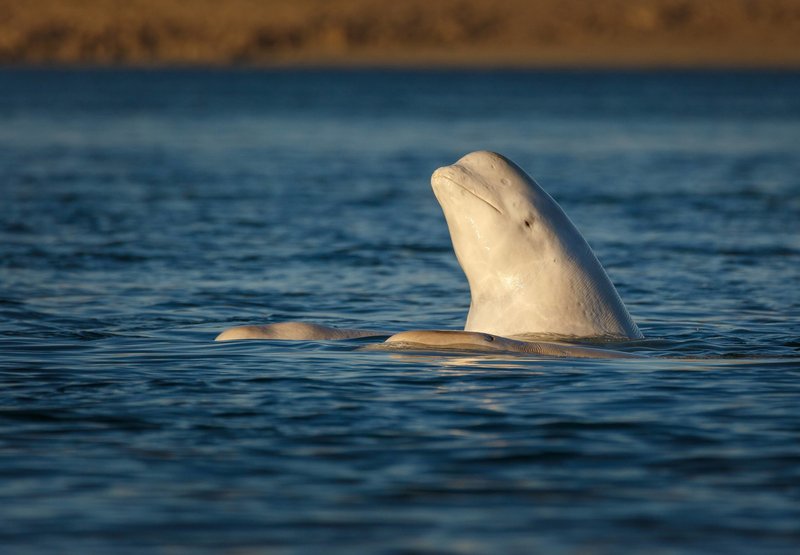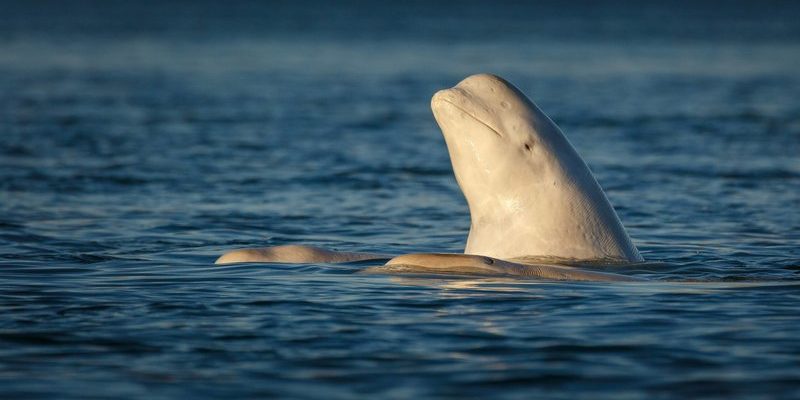
Beluga whales are one of the most delightful creatures found in the ocean. Imagine a whale that is almost as white as a snowflake, known for its friendly demeanor and playful behavior. These marine mammals, often called “canaries of the sea” due to their wide range of vocal sounds, are not just cute; they are fascinating animals with unique adaptations that help them thrive in their cold, Arctic waters.
When you think of whales, you might picture enormous creatures gliding through the ocean depths. Belugas, however, are smaller and incredibly social. They live in pods and are highly communicative, often squeaking and chirping to each other. If you’ve ever seen a dog wag its tail excitedly, you can imagine how these whales interact—full of energy and personality!
Join me as we dive into the world of the beluga whale. We’ll explore their physical traits, behaviors, habitats, and why they hold such a special place in both marine ecosystems and human hearts.
Physical Characteristics of Beluga Whales
Beluga whales are known for their striking appearance. Adults typically reach 13 to 20 feet in length and can weigh between 1,100 to 2,500 pounds. What’s particularly fascinating is their color. Young belugas are born gray and gradually turn white as they mature. This bright white color not only helps them blend in with their icy environment but also reflects their lively and curious nature.
The beluga’s body is robust, with a rounded forehead and no dorsal fin, which helps them navigate easily under the ice. Instead of a dorsal fin, they have a prominent dorsal ridge, which aids in swimming beneath the ice. Their skin is smooth and thick, providing insulation against the frigid waters of the Arctic. When you see a beluga swimming, it almost looks like it’s waving hello with its paddle-like flippers!
Another fun fact? Beluga whales have a unique adaptation: their flexible necks. Unlike most whales, which have fused neck vertebrae, belugas can turn their heads side to side. This ability gives them an edge when hunting or communicating with pod mates. Just think of them as the yoga instructors of the sea, gracefully stretching and moving with ease!
Habitat and Distribution
Beluga whales are primarily found in the Arctic and sub-Arctic regions. They thrive in cold waters, often living in areas with sea ice, which provides both protection and a hunting ground. You might find them near the coasts of Canada, Alaska, Greenland, and Russia. During the summer months, they migrate to shallow, coastal areas, where they feast on fish, crustaceans, and other marine life.
Interestingly, belugas are quite adaptable. They can often be spotted in rivers and estuaries, especially during the warmer months when the ice melts. This adaptability helps them find food and shelter, but it also makes them more vulnerable to human activities. Pollution and climate change are serious threats that affect their habitats, so their future is something we must all care about.
When observing these magnificent creatures, you might notice their playful nature as they swim through icy waters. They love to surf on waves, spy-hop to check out their surroundings, and even play with each other. This playful behavior showcases their intelligence and social bonds, which are vital for their survival in such a challenging environment.
Diet and Feeding Habits
Beluga whales are versatile eaters and will snack on whatever is plentiful in their environment. Their primary diet consists of fish, squid, and crustaceans, including shrimp and crabs. Belugas are often seen foraging in the shallow waters, using echolocation to find their next meal. Imagine sending out tiny sonar waves and listening for the echoes to locate fish—what a cool skill!
One fun aspect of their feeding strategy is their ability to use bubble-net feeding. This involves blowing bubbles to corral fish into a tight circle, making it easier for them to swoop in and grab a tasty treat. This method shows not only their cleverness but also how they communicate and work together as a pod.
You might be surprised to learn that belugas can consume up to 2,000 pounds of food each day, especially during the summer when food is abundant. They use their flexible necks to maneuver easily and chase after swift fish, showcasing their agility in the water. This endless buffet makes the life of a beluga whale as much about socializing as it is about feeding!
Behavior and Social Structure
Beluga whales are incredibly social creatures. They live in groups called pods, which can range from just a few individuals to over 100 whales! These pods are often made up of family groups. Just like we might gather with friends and family at a holiday celebration, belugas rely on each other for support and companionship throughout their lives.
Communication is key in beluga society. They use a variety of vocalizations, from whistles and clicks to squeaks and moos. Some researchers believe that these sound patterns can even convey emotions or specific messages. It’s like they have their own language, which helps them maintain social bonds and coordinate hunts.
You might also notice that belugas are playful, often seen jumping and swimming together in joyous displays. This playful behavior is not just for fun; it enhances their social skills and strengthens relationships within their pods. Watching a pod of belugas interact is like seeing a bustling community get together for a good time, where everyone has their role to play!
Conservation Status and Threats
Despite their charming demeanor, beluga whales face various threats that put their populations at risk. Climate change is perhaps the most significant threat, as it leads to melting ice, which they rely on for breeding and hunting. As their habitat changes, finding food and shelter becomes more challenging, directly impacting their survival.
Additionally, pollution in Arctic waters can accumulate in their bodies, making them susceptible to disease and reducing their ability to reproduce. Industrial activities, such as shipping and oil drilling, also pose serious threats to their habitats. When you think about the struggles these whales face, it’s hard not to empathize with them. They are not just another animal; they are an essential part of our marine ecosystem.
Conservation efforts are crucial to protect belugas and their habitats. Initiatives include protecting critical habitats, reducing pollution in their waters, and monitoring populations to track their health. Organizations and governments are working hard to ensure that these enchanting creatures continue to thrive in our oceans.
Fun Facts About Beluga Whales
Beluga whales are full of surprises! Here are a few fun facts that might leave you smiling:
- Color Change: Belugas are born gray and turn white as they mature, a transformation that can take up to 8 years!
- Vocal Talents: They can produce over 30 different sounds, which helps them communicate with each other.
- Submarine Vibes: Belugas can dive up to 2,300 feet in search of food and can hold their breath for up to 20 minutes!
- Social Creatures: These whales are known to form strong family bonds and often stay with their mothers for years.
Beluga whales are truly remarkable beings with a charm that captures the hearts of many. From their playful nature and social structures to their adaptability in the Arctic environment, they remind us of the wonders of the natural world. As we continue to learn about and protect these gentle giants, we’re not just safeguarding their future; we’re also preserving a vital part of our planet’s ecosystem. Remember, every time you hear a beluga’s call, it’s more than just a sound; it’s a reminder of the beauty and fragility of life beneath the waves.
FAQ
What is the average lifespan of a beluga whale?
Beluga whales typically live between 30 to 50 years in the wild, but some have been known to live even longer, especially in protected environments. Their longevity often depends on environmental factors and availability of food, as well as their overall health.
How do belugas communicate?
Belugas are incredibly vocal and can produce a wide range of sounds, including whistles, clicks, and chirps. These sounds serve various purposes, such as social interaction, navigation, and hunting. It’s fascinating to think of them as the “canaries of the sea,” using their voices to connect with pod mates and express their emotions.
Are beluga whales endangered?
Beluga whales are not classified as endangered, but some populations are considered vulnerable due to threats like climate change, pollution, and habitat loss. Conservation efforts are important to monitor and protect their populations, ensuring they continue to thrive in their natural habitats.
What do beluga whales eat?
Beluga whales have a varied diet that primarily consists of fish (like salmon and herring), crustaceans, and squid. Their flexible feeding habits help them adapt to the changing availability of food sources in their environment, making them versatile hunters.
Where can I see beluga whales?
Beluga whales can be found in the Arctic and sub-Arctic regions, including areas near Alaska, Canada, Greenland, and Russia. They are often spotted in coastal areas during the summer months when they migrate for feeding. Some aquariums and marine parks also house belugas, offering an opportunity to see these animals up close in a more controlled environment.
How fast can a beluga whale swim?
Beluga whales are not the fastest swimmers, but they can reach speeds of up to 5 miles per hour. This speed is sufficient for them to move gracefully through their icy waters and chase after their prey. Their agility in water allows them to maneuver effectively while hunting and interacting with their pod.
Do belugas have any predators?
In their natural environment, beluga whales have a few predators, including orcas and polar bears. However, humans pose the greatest threat to their survival through activities like hunting, pollution, and habitat disruption. Protecting belugas means addressing these human-induced dangers.
Can beluga whales be trained?
Yes, beluga whales have shown remarkable intelligence and can be trained for various tasks. In some marine parks, they are trained to perform in shows or engage in interactive experiences with humans. However, it’s important that such training emphasizes their well-being and natural behaviors.
How do belugas adapt to their icy habitat?
Belugas have several adaptations that help them thrive in icy waters, including a thick layer of blubber for insulation and the ability to dive deep in search of food. Their white coloration provides camouflage against ice, and their echolocation skills allow them to navigate and hunt effectively, even in murky waters.
How can we help protect beluga whales?
There are many ways we can help protect beluga whales! Supporting conservation organizations, reducing pollution, and advocating for sustainable practices can all make a difference. Additionally, spreading awareness about the challenges these whales face helps build community support for effective conservation efforts.

